

S TORY ON PAGE STORY 3 REMEMBERING OUR STORIES Illustration by Regi Taylor Illustration Vol. 50 No. 5• The Journal For Community News, Business & The Arts • insightnews.com Vol 50 No 5• The Journal For News, Business & The Arts • insightnews com January 30, 2023 - February 5, 2023 30 2023 - 5 2023 INSIGHT NEWS IS AUDITED BY THE ALLIANCE FOR AUDITED MEDIA TO PROVIDE OUR ADVERTISER PARTNERS WITH THE HIGHEST LEVEL OF MEDIA AS SURANCE. I N S I G H T N E W S I S A U D I T E D B Y T H E A L L I A N C E F O R A U D I T E D M E D I A T O P R O V I D E O U R A D V E R T I S E R P A R T N E R S W I T H T H E H I G H E S T L E V E L O F M E D I A A S S U R A N C E Insight News News
abilities
An article published by the Brooking Institute stated that the underrepresentation of Black businesses does not come from a lack of will or talent. Rather, the underrepresentation of Black businesses encapsulates a myriad of structural barriers underscoring America’s tumultuous history with structural racism. One of the principal barriers to the growth and development of Black businesses is that Black households have been denied equal opportunities for wealth accumulation. The median Black household’s wealth ($9,000) is nearly one-fifteenth that of non-Black households ($134,520). The article states that 90% of new businesses among all races do not receive any outside investors. Most people use the equity in their homes to start their firms. This is a huge disadvantage to Black folks in Minnesota because of the home ownership gap. Further, the report stated that minority owned businesses experience higher loan denial probabilities and pay higher interest rates than white-owned businesses even after controlling for differences in credit-worthiness, and other factors. Limited access to investment capital in its many forms is inextricably linked to systemic discrimination in lending, housing, and employment. It cripples Black business development.

2. Employment Invest now in creating employment opportunities for the Black community
In an article published by the Urban Institute, the issue of Black employment was addressed. It stated that, “while many are heralding the drop in the national Black male unemployment rate, which recently fell below 10 percent for the first time in seven years, joblessness remains much higher in many poor African American communities. It stated that for many low-income Black men, finding and keeping work is a constant struggle, never far from their minds. Black job applicants might not even make it into the queue if they have had an encounter with the criminal justice system. Helping Black folks secure steady employment at decent wages will require resources to break down the institutional barriers that separate people from decent job opportunities and to enable Black people to build the skills needed for well-paying jobs
3. Public Safety
Invest now in Public Safety in the Black community. Public safety exists to protect citizens, organizations, and communities by preventing them from being in danger and guarding their well-being. Abraham Maslow defined safety in his famous “Hierarchy of Human Needs“. He said that to function as a society public safety is needed. He said this safety goes beyond just physical safety but also safety when it comes to health, money, possessions, and family. Less we forget, there’s an Emotional Impact on Public Safety. When folks feel unsafe, it could have major effects on individuals, their loved ones, and the community they live in. Violence has been way to prevalent in the inner cities of Minneapolis and St. Paul. Playgrounds are unsafe, the streets are unsafe, and the shopping malls are unsafe.
home ownership
Multiple housing options are an important part of any community. It provides a safe and affordable place for people to live and can help reduce poverty and homelessness. However, there are many challenges associated with providing low-income housing, such as limited resources, high demand, and the need to ensure that the housing is safe and secure. Minneapolis has one of the widest homeownership gaps in the country between whites and Blacks.
5. Education Invest now in ensuring that our Black students are educated at the same level as White students.
Dr. Sinclair Grey lll stated that education is without a doubt crucial to the success of our students competing for jobs. Quality education that enforces and reinforces math, science, writing, and cognitive thinking will separate those who desire a prosperous future from those who are simply content with getting by. Yet, in Minnesota, reading test scores for Black students are over 20 points below state average and math test scores are 20 points below state average. Minnesota ranks 50th in the nation for Black students who graduate on time. Minnesota has one of the worst college-readiness gaps in the nation by race and ethnicity – only 25% of Black students are prepared for college. Thus, Black students who attend college must take significantly more remedial courses than their peers as their starting point.
6. Health & Wellness Invest now in efforts that will impact the health and wellness of the Black community. The Black community is faced with escalating social, economic, and life-style problems, which threaten the life and well-being of current and future generations of Black people in crisis proportion. The rising number of deaths due to heart disease and stroke, homicide and accidents related to substance abuse, AIDS, cancer, and infant mortality are among the leading culprits. They interfere with prospects of longevity and contribute to joblessness, poverty, and homelessness and further complicate the crisis in the Black community. The magnitude of the problems dictates the need for support from the Minnesota State Legislature.
7.

Policy
Each member of the legislature, regardless of political affiliation, is involved in setting public policy. These policies should reflect the will of the people and is carried out by those elected to vote. Because of conflicting interests and capacities, some policies have disenfranchised the Black community. There is therefore a need for coherence of interest/capacities in an attempt to pass policies that reflect the needs of the Black community.
Every time another national “quality of life” is broadcast or published about the best places to live in the U.S., Minnesota and the Twin Cities always rank at or near the top. The Atlantic’s Derek Thompson once referred to this as the miracle of Minneapolis.” Likewise, every time those lists are parsed out further, the state and the metro fall all the way to the bottom when it comes to quality of life measures for Black people, or, what some have called the “Two Minnesotas.” But to ensure that all those in our state have the opportunity to thrive, we cannot forget about the communities that have been systematically abused, persistently underrepresented, and long underserved.
Minnesota is now the seventh (7th) worst state in the country for Blacks to live. This dubious recognition alongside the May 2020 murder of George Floyd has brought the State into an era of racial reckoning and has put racial inequity at the center of the national conversation, and Minnesota on the racial map. Today Black folks are more than twice as likely as their white counterparts to live below the poverty line. Additionally, the typical Black household earns just 63 cents for every dollar a typical white household earns, and African American workers are more than twice as likely to be unemployed as white workers.
Using data from the U.S. Census Bureau, 24/7 Wall St. created an index to measure socioeconomic disparities between
and white Americans
the worst states
Black Americans. High on the list of cities that have extremely troubling disparities is Minneapolis-St. Paul. Minnesota’s urban core boast these disturbing rates:
• Black population: 290,210 (8.2% of total)
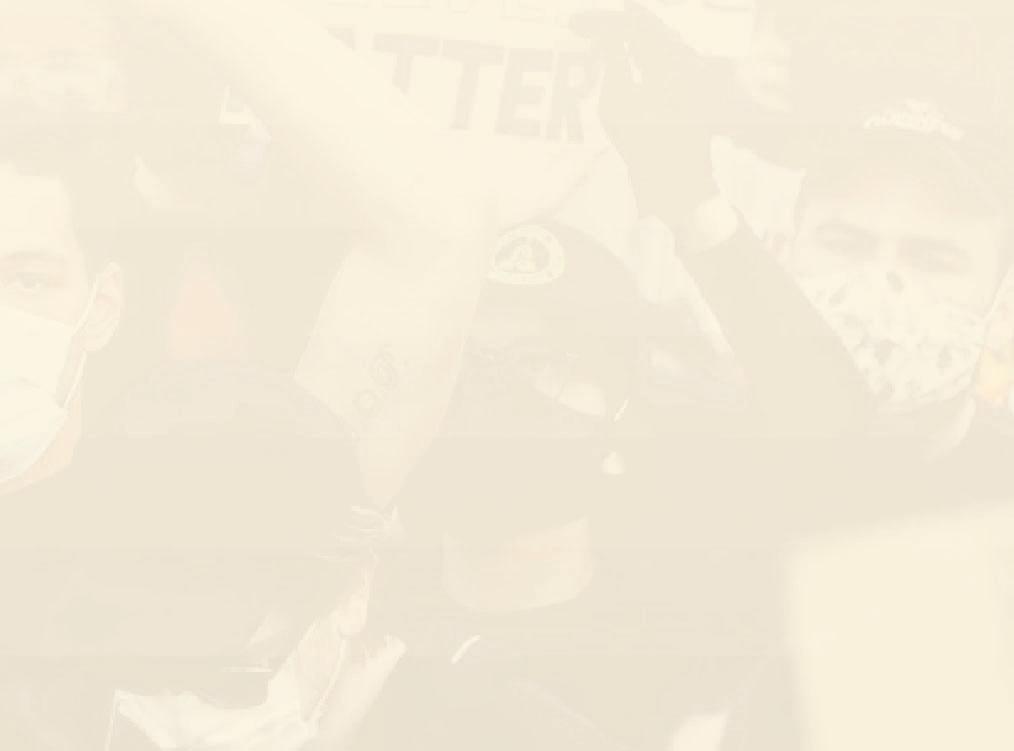

• Black median income: $36,127 (44.0% of white income)
• Unemployment: 9.2% (Black); 3.2% (white)




• Homeownership rate: 25.2% (Black); 75.5% (white)
• Black poverty rate of 28.3% in the metro area, 5.9% (white)
• Black medium household earn $36,127 a year — the median income among white area households is $82,118.
The profound racial wealth gaps for Blacks in Minnesota is structural, as they are across the United States. Structural racism is inherent in intersecting and overlapping institutions, policies, practices, ideas, and behaviors that give resources, rights, and power to white people while denying them to others. The roots of racial wealth gaps can be traced back centuries through racialized public and private policies and practices, which fueled economic boosts to white families that allowed for intergenerational wealth transfers and created barriers to Black families.
Past discrimination and injustices accumulate and build across generations, making it hard for communities that have been harmed to catch up. As one example, the losses from unpaid wages and lost inheritances to Black descendants is estimated at around $20 trillion today. The NAACP Twin Cities 2019 Economic Inclusion Plan states: “There are two Minnesota’s, one white, one Black – separate and unequal.”
Data from the 2019 Prosperity Now Scorecard shows that 40% of Americans are liquid asset poor—meaning they do not have enough in savings to make ends meet at the poverty level for three months ($6,275 for a family of four in 2018). This problem is even more stark when disaggregated by race. 31.7% of white households are liquid-asset poor compared to over 62% of Black households.
Recent trends in Hennepin and Ramsey Counties are moving in the wrong direction. The share of Black families who own a home has declined from 31 percent in 2000 to 21 percent in 2018. The racial homeownership gap in the Twin Cities is the highest in the nation and has only widened over the past two decades, especially in neighborhoods where investors have acquired hundreds of single-family homes to now use as rentals, according to a June 2021 report from the Urban Institute.
Page 2 • January 30 2023 - February 5 2023 30, 2023 - 5, 2023• Insight News insightnews.com BLACK MINNESOTA PRIORITIES • Equity in distribution and stewardship of resources • Advancing innovation and collaboration in problem solving • Upending traditional systems • Bringing the voices of community front and center THE URGENCY OF NOW! • Minnesota’s record budget surplus enables addressing disparities in a meaningful way •We demand genuine inclusion in the resource allocation process •We must outline, up front, what this inclusion looks like THREE STEPS BACKGROUND INVEST NOW! 2023 UNITED BLACK LEGISLATIVE AGENDA 1. That
t0 affirms
to prioritize disparities elimination in all aspect of Minnesota governance and administration. 1. Business and
Invest
Minnesota governor Tim Walz, meets with representatives of Minnesota Black communities
Minnesota’s commitment
Economic Development
now in Black folks and their
to create businesses in the community.
Black
to identify
for
4. Housing Invest now in multiple housing options for the Black community to close the
gap.
2. That the Governor hold his appointed State Commissioners and the state departments they lead accountable for measurable and reportable processes and strategies to eliminate disparities that exist in and that are supported by policies and procedures of state governance.
3. That the Minnesota Legislature prioritize intentional solution making that can occur when Legislators, Committee Chairs and Committees engage Minnesota’s Black community at the table of decision.
Does ‘Black History Month’ adequately honor our African American
By Regi Taylor Contributing Writer
On a recent episode of The Conversation with Al McFarlane, a regular expert guest lamented that over his lifetime he has been identified in various legal documents as Colored, Negro, Black, and African American. As we approach ‘Black History Month’ 2023 is it time to reconsider how we as a people define ourselves?

In the case of our former celebration of racial pride, prior to Black History Month, we honored our ethnicity during Negro History Week, instituted by Harvard-educated historian, Carter G. Woodson in 1926, when his move was a very bold political statement.
For half a century, until 1976, ‘Negro’ History Week as an observance of pride became passé. Starting in the late 1960’s, bolstered by the James Brown song, ‘Say It Loud, I’m Black and I’m Proud,” Black History Month replaced the former one-week
designation, observed the second week of February which coincided with the birthdays of Abraham Lincoln and Frederick Douglass.
As we approach another 50 years, 2026, of celebrating our ancestral heritage as Black History , is it time to update the definition again of who we are as a people?
I first broached this idea as a college freshman in the late 1970’s, soon after Black History Month began.
As the producer and host of Backstage with Regi Taylor , a weekly public affairs talk show on WMTB-FM, Mt. St. Mary’s University radio, I broadcast an announcement to the school’s 2000 Caucasian and 15 African American students about my upcoming show where I would discuss discontinuing Black History Month.
The campus’ racial groups were beside themselves. The mostly
German, Irish, and Italian kids were ecstatic. What a sensible discussion to have was the feedback I was getting from them. The African American kids were dumbfounded, or maybe they just thought I was dumb, but they damn sure didn’t like it.
However, when I broadcast the live callin show, I got the reverse reaction from both groups.
I never wanted to suspend a celebration of our ancestry, I only wanted to redefine the observance by calling it African American History Month
I have always felt conflicted about ‘Black’ History Month. Why have we allowed our great heritage to be artificially distilled and defined as a color? Should European history be ‘white’? Asians, ‘yellow’? Hispanics and Near Easterners, ‘brown’? Native Americans, ‘red’?
Not only are we relegating our rich history as a people to a benign
description subject to any cultural interpretation by anyone, allowing detractors to discard our ancestral lineage for a definition that simply defines us in the vane of Jim Crow, a people whose history only began on American shores as the lowest among this country’s caste system; and this is our upgraded, post-slavery status.

We have been known as, and answered to, Slave, Nigger, Colored, Negro, Black, and African American. Which is it going to be? Who are we, really? Which moniker best defines our ancestry? Black is damn sure Beautiful, but it is our image, our appearance, how we look, not who we are in our genealogic and geographic essence. Moreover, ‘Black,’ and ‘white’ may be at the core of what exacerbates continued racial strife in America. These two artificial colors describing diverse ethnic Americans
Changing communities through music, culture, and urban farming
By Pulane Choane, Contributing Writer
December 18th marked 157 years since 1865, when the 13th Amendment was officially adopted into the American constitution, thus abolishing slavery in all states of the country. Despite the strides made over the last century to dismantle segregation, the legacies of slavery continue to be a painful part of American history.
Movements like Black History Month which elevate the contributions of African Americans challenge and destroy supremacist narratives, supplanting the factual accounts of Black resistance and resilience – traits that force America to examine its failure to live up to its professed ideals of democracy and freedom and inalienable human rights.

African Americans found new ways of being,
culture, and identity as we defeated centuries of slavery.
One of the spaces where Africans-Americans preserve culture is music, including referred to as Negro spirituals which historically were a type of religious folk
song that the enslaved sang.
Chicago-based jazz vocalist, historian, educator, and urban farmer Bruce A. Henry, speaking on The Conversation with Al McFarlane, said through his study of the evolution of music over the last

Gov. Walz’s proposed budget largest in state history, includes
 By Steve Abrams Minnesota House Session Daily
By Steve Abrams Minnesota House Session Daily

Minnesota can be the best state in our country for kids to grow up.
That was Gov. Tim Walz’ mantra Tuesday during the unveiling of his proposed budget for the next two fiscal years.
“Over the last week, we laid out our plan to make Minnesota the best state in the nation for children, invest in our economic future, combat climate change, and improve public safety across the state.
Today, we lay out the full picture of how this budget will lower costs, cut taxes, and improve lives for Minnesotans,” Walz said. “For a middle-class family of four, the One Minnesota Budget could put $10,000 back in their pocket. We are delivering a transformational budget for Minnesotans, and I look forward to getting this done.”
His budget would see expenditures totaling $65.2 billion while also containing $8 billion in tax cuts – both record highs for a biennium. It would also spend the lion’s share of the state’s estimated $17.6 billion surplus, in the form of both spending and rebate checks.
Arguing Minnesota has a once-in-a-generation
in tax cuts
opportunity to think afresh about the future and chart a sustainable path forward, Walz’ budget would have a far-ranging impact on the state’s finances and families.
House DFL leaders voiced strong support for the proposal.
“The Governor’s budget reflects the values of Minnesotans: we value great public schools, affordable health
Liz King
Civil Rights community details education landscape in 2023
The Leadership Conference Education Fund — joined by the Lawyers’ Committee for Civil Rights Under Law, the Legal Defense Fund (LDF), Autistic Self Advocacy Network (ASAN), Intercultural Development Research Association (IDRA), and the National Women’s Law Center (NWLC) — held a press briefing to discuss urgent education priorities for 2023. The civil rights community detailed threats and opportunities for students in the new year and foreshadowed what to expect. Experts and advocates spoke on the Supreme Court challenges to federal student loan debt cancellation and affirmative action in higher education, in addition to school discipline, threats to equal educational opportunity, and early care and education.
“We know that education policy decisions must be informed by the values, priorities, and experiences of marginalized people. For too long, people of color, Native people, LGBTQ people, people with disabilities, immigrants,
religious minorities, English learners, girls, low-income people, and other marginalized people have had their stories told by someone else. Their opportunity to attend a school that is warm, welcoming, and that prepares them for the full exercise of their social, political, and economic rights has been denied,” said Liz King, senior director of education equity at The Leadership Conference Education Fund. “As students, families, educators, and school communities continue to recover from the effects of the COVID-19 pandemic, we know that a return to 2019 isn’t good enough. Normal isn’t good enough. Every child deserves access to an excellent equitable education that prepares them for the future. It is their right and our national imperative.”
“There are alarming attacks on education equity and pathways to economic opportunity, especially for Black and Latinx people, on this year’s Supreme Court docket. It’s becoming increasingly

insightnews.com Insight News • January 30 2023 - February 5 2023 30, 2023 - 5, 2023 • Page 3
400 years, he has also learned many lessons in the history of African American music.
“One of them is when I look at West African music influences in early
Bruce Henry at Dakota
BHM
4
HENRY 6
ancestry and heritage?
photo/Paul Battaglia Gov. Tim Walz, pictured here last year, on Tuesday unveiled his complete $65.2 billion two-year state budget proposal he says will “make Minnesota the best state in the nation for children.”
WALZ 4
$8 billion
EDUCATION 6
LinkedIn
Insight News Insight News Vol 50 No 5• The Journal For Community News, Business & The Arts • insightnews com Vol. 50 No. 5• The Journal For Business & The Arts • insightnews.com January 30, 2023 2023 - February 5, 2023 - 2023 I N S I G H T N E W S I S A U D I T E D B Y T H E A L L I A N C E F O R A U D I T E D M E D I A T O P R O V I D E O U R A D V E R T I S E R P A R T N E R S W I T H T H E H I G H E S T L E V E L O F M E D I A A S S U R A N C E INSIGHT NEWS IS AUDITED BY THE ALLIANCE FOR AUDITED MEDIA TO PROVIDE OUR ADVERTISER PARTNERS WITH THE HIGHEST LEVEL OF MEDIA AS SURANCE. News Lawmakers advance bill seeking $280 million to fund ‘innovative’ crime prevention programs PAGE 5
PAGE 7
Review A Retrospective Review: “The ‘New’ Jim Crow” by Michelle AlexanderSounds More Like the ‘New Slavery’
Where
Leticia Nieto and Karine Bell are launching a 4-month long exploration specifically for people who occupy the cracks in our conversations about race. That is, they’ve long imagined a space where those of us who identify as bi/multicultural could - in our commitment to anti-Blackness and antiracism- steep in an exploration of these borderland identities.
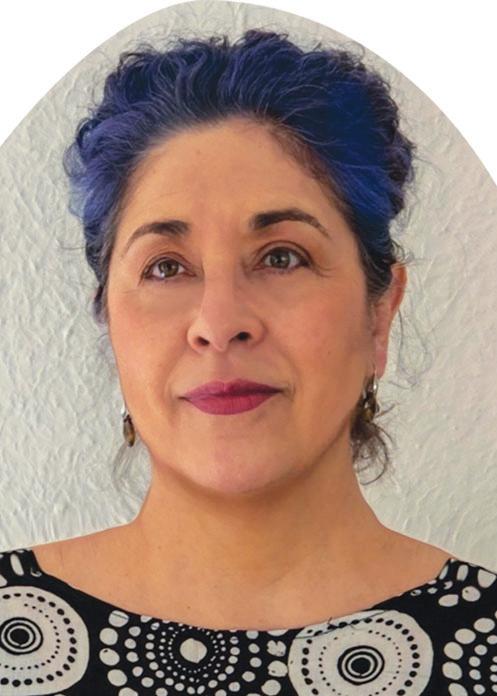
This program is called — Where Do I Belong? An Exploration of identity and belonging for bicultural and multicultural bodies.
This playful, experimental space will explore these identities that defy distinct categorizations through the skillful and
Belong? An Exploration of identity and belonging
intentional guidance of Leticia Nieto, weaving in authentic movement, psychodrama, sociodrama, playback theater, phototherapy, and song.
This is a playful and exploratory environment, in which we will emphasize what Leticia Nieto calls an “ethic-to-encounter” rather than an environment of discussion and debate.

This means that we enter in with a willingness to risk what we know, and release the need to know with certainty (or to convince others of our certainty). This requires a level of self-responsibility and a willingness to stay with questions that linger, with curiosity and a willingness to
not know — to be open to being surprised and guided by what emerges for us in the process. This is for you, If….
You’re willing to accept this as a space of suspended knowing and encounter - rather than
discussion and debate.
You relate to the experience of not knowing where you belong in conversations about race.
You wonder how or where you could explore the multiple, sometimes contradictory, aspects of your lived experience.
You want to engage experientially with the diverse experiences of identity you hold. You want to do this communally! You’ve longed to connect with other people who identify as bi-cultural or ‘mixed’ to witness and share experiences.
You are curious to know what new possibilities could emerge for how you
experience belonging in your life now.
This first iteration of the course will focus on bi/multicultural experiences of those in North America, acknowledging that how racialization and difference manifests in other global contexts is different. Even within the United States and Canada, there are myriad experiences we hope to include. Come learn more and register (space is limited!) And please feel free to share this program with others you think might be interested!
For further information go to the website at: https:// www.rootedglobalvillage. com/belonging-ambiguityproject-2023.
Evictions on the rise in MN— a crisis ‘bigger than before’ the pandemic, committee hears
 By Tessa Pieper House Session Daily
By Tessa Pieper House Session Daily
Over 22,000 evictions were filed in Minnesota last year. In other words, one in 30 renter households across the state faced an eviction.

Rachael Sterling, a housing attorney at HOME Line, told the House Housing Finance and Policy Committee Tuesday that the eviction crisis didn’t start when the eviction moratorium phaseout expired in 2022. She said that it was going on prior to the pandemic, but it is still here and bigger than before.
Ron Elwood, a supervising attorney at Mid-

From 3
couldn’t possibly position us to be further apart.
Black and white are polar opposites, a dichotomy of extremes, as far apart as two colors – or peoples –could ever be, making it more difficult on a visceral level to recognize how we are more the same than different when viewed exclusively through a diametric prism.
If we must go with colors, perhaps we should identify Americans of European and African ancestries as Vanilla and Chocolate, respectively. These two flavors actually go well together, and on a gradient spectrum you can
Walz
From 3
Minnesota Legal Assistance, shared the driving factors behind housing struggles that his organization has noticed. These include housing unaffordability, the length of time it takes to make new units accessible, the gap between the need and availability of rental assistance, the court process and the current challenge of finding housing with an eviction filing on record.
“On the one side of the ledger, landlord’s and the public’s legitimate right to know who they’re renting to is absolutely important,” Elwood said. “But on the other hand, an eviction filing is merely an allegation, an unproven allegation, but it becomes a
connect the dots from one color to the other fairly simply. Not as easy to do with the stark divide between black and white.
While we’re at it, we definitely need to get rid the inherently racist, ‘minority.’ What the hell is a minority ? What makes one a minority? Think about it. A minority is foremost any ‘non-white’ person. But there really are no ‘white’ people. The term is a euphemism for ‘us’ and ‘them;’ ‘legitimate’ Americans versus the others I was amazed as a college freshman, the first time in my life I had ever attended school with, or otherwise been in a predominant environment among, Caucasians. I realized immediately that in their interactions with one another they did not identify
care, and an economy that works better for everyone. House DFLers share these goals and values,”


scarlet letter regardless of the outcomes or merits of the case. It follows a person for at least seven years.”
Working with tenants, landlords and attorneys, Brittani Walker helps facilitate the process of rental assistance during court proceedings.

As a case management assistant with Hennepin County, Walker said: “The underlying issue that I see is that these tenants don’t know their rights, they are not allowed enough time to round up funds that they need, and the lack of compassion and understanding of their situation which most times is out of their control.”
Both a tenant in St. Paul and a tenant organizer
as white . There was abundant ethno-cultural preening at The Mount
The students’ bumper stickers were revealing: German kids: “Geil!”, Awesome; Irish kids: Erin go Bragh , Ireland forever; and the Italians: “La Dolce Vita,” The Sweet Life. Never saw ‘White Power!’
Is it only when Caucasians are compared to ‘minorities’ that they readily identify as white?
Many ‘whites’ who relish their ‘majority’ status, and those who have denigrated ‘minorities,’ have conveniently forgotten the treatment of their own non-Anglo-Saxon ethnic ancestors.
Color notwithstanding, the largest ancestral group in America are those of German
Park) said in a statement. “I commend the Governor for proposing a bold budget with an inspirational vision for our future. I look forward to our continued partnership as we craft our budget.”
Republicans, however, offered forceful criticisms during an afternoon press conference.
“In a time there is a record surplus, $17.6 billion, Minnesotans are expecting to have that back,” said House Minority Leader Lisa Demuth (R-Cold Spring). “Unfortunately, what we heard today is Minnesota is spending and it’s going to cost Minnesotans a little bit more to be here. That was a little bit surprising. If we can’t cut taxes now, when can we?”
While Republicans are open to the rebate checks, Demuth said they would rather see the governor focus on permanent tax cuts, including the elimination of the state tax on Social Security income.
Lots of movement on taxes
Emphasizing Minnesota’s history of progressive taxation, Walz plainly stated that he intends to continue that tradition.
Primarily, he would like to send checks directly to Minnesota residents. Individuals making less than $75,000 a
with HOME Line, Katherine Banbury spoke on behalf of tenants who could not attend the informational hearing, whether because they could not take time off work or they fear retaliation from landlords should they choose to testify.
She shared stories of late payments due to work injuries or lost jobs, as well as the tenants’ challenges finding rental assistance after an eviction or consequential homelessness.
“Families with small children, vulnerable adults, and minorities are particularly at risk for losing their homes without rental assistance,” said Jacfar Khalif, an organizer at New American Development Center.
extraction, more than 1 in 6. Despite nearly six million Germans immigrating to the U.S. between 1820 and 1930, ethnic Germans were openly discriminated against during the period covering the 1 st and 2 nd World Wars, suffering harassment, internment, and lynchings.
Americans of Irish ancestry are currently nearly 1 in 10 of the U.S. population, 9.7%. During the height of their migration to the U.S., between 1850 and 1920, more than 3.5 million settled here. They faced similar discrimination as the Germans. Even the first Irish American president of the United States in 1960, John F. Kennedy, faced open ethnic hostility and anti-Catholic sentiment.
Italian Americans, 1 in 20 of the U.S. population, faced virulent prejudice during

year would receive $1,000 and families earning under $150,000 a year would be eligible for $2,000. Households would also qualify for an extra $200 per dependent (with a limit of three). This money would be non-taxable and would come out of the surplus, totaling nearly $4 billion.
Tax credits for child care costs are on the table for families making under $200,000. This would total over $1 billion over four years. Meanwhile, tax credits tailored specifically for lower-income families would result in tax cuts of $1.1 billion in 2024-25 and $1.2 billion in 2026-27.
In regards to seniors and the contentious state tax on Social Security benefits, Walz would keep it in place but reduce this tax burden to the tune of $219 million.
Revenue Commissioner Paul Marquart said those actions would cut child poverty by 25% and reduce Social Security taxes for around 90% of seniors, respectively.
Walz would like to see an increase on one stream of income, however: capital gains. He proposes a 1.5% surcharge on capital gains and dividends exceeding $500,000 and a 4% surcharge on those exceeding $1 million.
As one-third of the current American Caucasian population, whose recent ancestors were considered ‘minorities’ and who were the victims of bigotry, harassment, discrimination, and violence, one might imagine that there would be greater sensitivity and empathy among today’s ‘whites’ towards so-called ‘minorities’ and immigrants.
In three to five generations these formerly marginalized immigrants have fully assimilated and assumed the mantle of majority ‘white’ status with all the inherent rights,
Other budget priorities
“Prohibition doesn’t work,” said Lt. Gov. Peggy Flanagan, referring to marijuana and the DFL’s hopes to legalize adult-use cannabis this session. The budget calls for funding to establish an Office of Cannabis Management to regulate a legal marketplace.
Over $750 million is recommended to fund cleaner transportation across the state. This would include purchasing electric buses to replace diesel buses operated by the Metropolitan Council, providing matching state funds for dollars headed Minnesota’s way from the federal government, and expanding the state’s electric vehicle charging infrastructure.
As for transit?
Per his budget, “The governor recommends enactment of a 1/8th cent sales tax in the seven-county metropolitan area, beginning in October of 2023, to expand investment in the regional transit system. The funds will be used with other federal, state and local resources to assist in addressing the operating and capital needs of the Metropolitan Council’s transit programs.”
Previously announced priorities Today’s presentation capped off a series of

privileges, and prejudices that attach. How do they view contemporary African Americans and other marginalized minorities ?
Well, again, what the hell is a minority? It’s been debunked that the artificial skin-color metric is a bogus measure of who is a minority. If we consider ethnicity as a measure, then people of Hispanic heritage are nearly 1 in 5; Germans, 1 in 6; and African Americans, 1 in 8
Despite 4-years of Trump’s menacing and malfeasance, racism and raunchiness, lying and larceny, insolence and insurrection, nearly 3 of 5 Caucasian Americans still gave the Odd-Toddler their vote. These people have clearly defined who they are. Who are we?
announcements coming from the governor over the last week. This included education, where Walz would like to increase the general education funding formula by 4% in 2024 and 2% in 2025; reduce the special education cross subsidy for local school districts by 50%; and institute universal school meals. This would amount to over $3 billion.

A package to broadly invest in Minnesota’s economic future, highlighted by a paid family and medical leave program, adds up to $4.1 billion. Walz believes this will make the state more competitive when it comes to attracting and retaining a high-quality workforce.
Additionally, $1.5 billion is included to expand access to affordable housing, with a special emphasis on eliminating veteran homelessness statewide. A public safety package totaling $300 million would also be distributed to city, county, and tribal governments.
Individual departments will be presenting their budgetary requests in greater detail to the relevant House committees in the coming weeks. A bonding proposal is also expected from the governor’s office on Thursday.
Page 4 • January 30 2023 - February 5 2023 30, 2023 - 5, 2023• Insight News insightnews.com
House Speaker Melissa Hortman (DFL-Brooklyn
the crest of their immigration. According to La Gazzetta Italiana, ethnic Italians were referred to by ‘real’ white Americans as “savages and drunkards, reducing them to social outcasts,” and committed physical violence against them.
BHM
Do I
Karine Bell Leticia Nieto
photo/Vyacheslav Dumchev
Insight News is published weekly, every Monday by McFarlane Media Interests. Editor-In-Chief Al McFarlane Publisher Batala-Ra McFarlane Associate Editor & Associate Publisher B.P. Ford Culture and Education Editor Dr. Irma McClaurin, PhD. Associate Editors Afrodescendientes Jesús Chucho Garcia Mestre Yoji Senna DaBahia Columnist Brenda Lyle-Gray Book Review Editor W.D. Foster-Graham Content & Production Manager Sunny Thongthi Yang Distribution/Facilities Manager Charles Royston Receptionist Lue B. Lampley Intern Naomi Thomson Photography Uchechukwu Iroegbu Lou Michaels Roy Lewis - Washington D.C. Artist Donald Walker Contact Us: Insight News, Inc. Marcus Garvey House 1815 Bryant Ave. N. Minneapolis. 55411 Ph.: (612) 588-1313 Fax: (612) 588-2031 Member: Minnesota Multicultural Media Consortium (MMMC) Minnesota Newspaper Association (MNA) National Newspaper Publishers Association (NNPA) Postmaster: Send address changes to McFarlane Media Interests, Marcus Garvey House 1815 Bryant Avenue North, Minneapolis, INSIGHT NEWS www.insightnews.com
Lawmakers advance bill seeking $280 million to fund ‘innovative’ crime prevention programs
By Tim Walker Minnesota House Session Daily
“To Protect and Serve” is a common slogan for law enforcement agencies.
But “To Heal and Restore” should also be part of that equation, says Rep. Cedrick Frazier (DFL-New Hope).
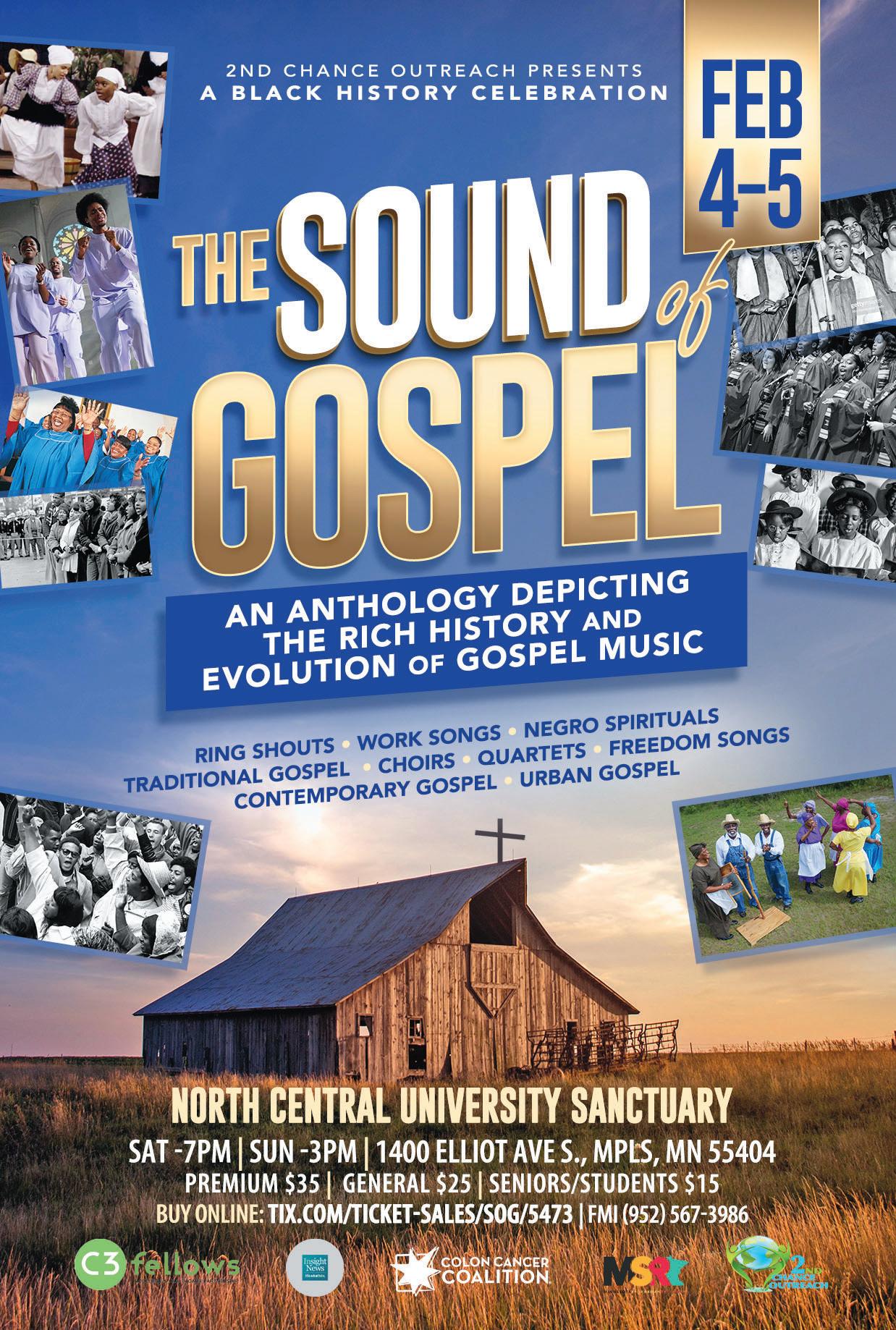

He sponsors HF25, which would expand the role of law enforcement and the criminal justice system by funding more communitybased crime prevention services, such as victim services programs and juvenile diversion programs. It would also provide funding for social service workers to accompany police when they respond to individuals experiencing a mental health crisis.
The bill takes
“an innovative and multifaceted approach … for the reduction, intervention, and prevention of crime,” Frazier said. There is also money to increase funding for more traditional law enforcement roles that have been successful.
The House Public Safety Finance and Policy Committee approved the bill, as amended, Thursday and sent it to the House Ways and Means Committee.
The bill proposes a one-time appropriation of $280 million in fiscal year 2023:
$205 million to the O
ce of Justice Programs: $150 million to fund grants to community groups for crime and violence prevention and intervention and $55 million to help local law enforcement agencies establish mental health crisis response teams; and
$75 million to
the Bureau of Criminal Apprehension to continue to partner with local jurisdictions to investigate violent crimes.
In addition, the BCA would get $10 million in the 2024-25 biennium to expand the work of its Use
of Force Investigations Unit. Although her work focuses on events after a crime has been committed, Hennepin County Attorney Mary Moriarty said she recognizes the most effective way to deal with crime is to prevent it from

happening in the first place.
“This bill represents a historic recognition that investing in prevention and intervention will help prevent harm and save lives,” she said.
Hennepin County Commissioner Irene Fernando said the county has seen great success in its recently established program to embed mental health workers with

police officers responding to mental health calls.
“This is an important step to improve the response we give to people,” she said. “The collaboration between public safety and behavioral health builds capacity within the emergency response system to better manage mental healthrelated calls.”
insightnews.com Insight News • January 30 2023 - February 5 2023 30, 2023 - 5, 2023 • Page 5
ffi
PBS
Rep. Cedrick Frazier
Twitter
Hennepin County Commissioner Irene Fernando
Hennepin County Attorney Mary Moriarty
African American roots performances, the idea of democracy flows through this vernacular music. The idea is that the performance is part of a community. That communities are free to create together.”
Henry says that this shared creativity could be observed in Black ancestoral music, as well as in jazz music and even folk. But in today’s




genres, Henry warns, with music evolving culturally and becoming more suited to global and predominately Western tastes, this creative, communal, and democratic aspect of music is diminishing rapidly.
“Music has become the realm of the virtuoso specialists, and we don’t feel free as individuals to participate and create as a community,” he says.
















Henry also notes that while many spirituals today are sung, he has, over the years, found that they are often sung without understanding the historical context they were formed in.

He adds that if more singers and performers understood the history behind some of these spirituals, they would sing them more meaningfully.
“When I went to Cuba, I had the honor to work with this wonderful choir, one of the best choirs in the world. They were singing Negro spirituals. They sang beautifully and intricately well. And then, I just asked them, ‘Do you know a story of our people? Do you know a story of how these songs were resistant, coded messages, et cetera?’ And they did not know. They had no idea.”
difficult for students to realize the full potential of their education between the threat of insurmountable student debt exacerbated by COVID19’s severe financial setbacks, along with a concerted effort to overturn affirmative action and turn back the clock on diversity and equal opportunity,” said Genevieve “Genzie” Bonadies Torres, associate director of the education opportunities project at the Lawyers’ Committee for Civil Rights Under Law. “We urge the court to affirm President Biden’s debt relief plan, which would provide essential relief for Black and Brown borrowers — especially women of color — who are still recovering from the economic fallout disproportionately shouldered during the pandemic. The Lawyers’ Committee is committed to fighting for every student’s right to receive a quality education and achieve financial security, regardless of economic status, gender, or race.”















“All students deserve a fair shot at getting a quality education, regardless of their income, where they grew up, or their racial and ethnic background. However, while talent is everywhere,



Henry says following their new insight into the songs they were singing, they sang the same songs with more depth and were transformed in their performance. The Chicagobased jazz vocalist says through his music and the curriculum he developed, which focuses on teaching communities the importance of culture and collaboration, he intends to ensure that more people, old and young alike, learn about the historical significance of spirituals. He has written
opportunity is not. Too many students of color must contend with systemic and interpersonal racism that detrimentally affects their educational opportunities,” said Michaele Turnage Young, senior counsel at the Legal Defense Fund (LDF). “Later this year, in lawsuits involving Harvard and UNC, the Supreme Court will decide whether colleges and universities can continue to consider race, as one of many factors, in admissions. It is important that colleges and universities continue to be allowed to consider the full context of applicants’ experiences, including the way that racism artificially depresses the prospects of many hardworking, talented, Black, Latinx, Native, and underserved Asian American students.”
“All students deserve safe, healthy, and inclusive school climates. Every student deserves the opportunity to attend positive school environments that support their rights, protect against harassment and discrimination, and ensure their health and safety,” said AJ Link, policy analyst at Autistic Self Advocacy Network.
“At IDRA, we know that culturally-sustaining schools are key to students’ success. Culturally-sustaining schools are places where every student feels welcome — no one is asked to check parts of their identity at the door;


hundreds of songs, including ‘Africa Cries’, which he explained was inspired by a dream and had very few lyrics. The lyrics say, “How can we rejoice when she is in pain? Africa will live to rise again. While the world lives on and we deny, how can we be happy while she cries?”


He also recently released a Christmas album on CD.

When Henry isn’t writing songs for social change, he is educating others on the evolution of music through his program, which aims to give those interested in the

everyone sees themselves and their communities reflected in the curriculum and instructional practices; diversity, equity, and inclusion efforts are meaningful; and everyone feels safe,” said Morgan Craven, national director of policy, advocacy and community engagement at Intercultural Development Research Association (IDRA) “We know that these types of learning environments are beneficial for all students and adults in a school community, and we must challenge any efforts to undermine them.”
“We are entering year four of a pandemic that pressure-tested an early care and education system already in crisis, causing devastating results across the country for early educators and families alike. For the early care and education sector, the COVID-19 pandemic has laid bare and exacerbated the deep inequities of an early care and education system that relies on families paying unaffordable sums, early educators being paid poverty level wages, and too many communities across the country lacking sufficient workforce or facilities to meet early care and education demands. These inequities disproportionately impact women and families of color. The pandemic has only brought more challenges, especially for women of color, who comprise a significant
intersections between music and culture an overview of African American music from 1619 to the modern music we hear today.
Finally, when he isn’t educating, he manages a community garden affiliated with a church in Chicago that helps feed hundreds in that community weekly. To purchase his music, book him for a performance or learn more about the historical foundations of music and the links between the music we know today and the music of our African ancestors, be sure to visit his website at https://www.bruceahenry.com/
portion of the underpaid early care and education workforce and have the least access to affordable care for their children. In order to ensure that children and families have access to and are included in comprehensive, diverse, and high-quality early care and education settings, we seek policies that reflect our coalition’s Civil Rights Principles for Early Care and Education,” said Whitney Pesek, director of federal child care policy at the National Women’s Law Center (NWLC). “In 2023, NWLC, along with the coalition, continues to engage and educate diverse stakeholders and policymakers around these principles to protect civil rights and advance equity for children, families, staff, and providers.”
The Leadership Conference Education Fund builds public will for federal and state policies that promote and protect the civil and human rights of all persons in the United States. The Education Fund’s campaigns empower and mobilize advocates around the country to push for progressive change in the United States. It was founded in 1969 as the education and research arm of The Leadership Conference on Civil and Human Rights. For more information on The Education Fund, visit civilrights. org/edfund/.

Page 6 • January 30 2023 - February 5 2023 30, 2023 - 5, 2023• Insight News insightnews.com
Henr y Henry From 3
Education From 3 PARTTIME DISTRIBUTION ROUTEDRIVER Onetotwodaysperweek. $15perhour. Validdriver'slicenserequired. Calltoapply 612-695-0417 WEARE HIRING
fi
By: W.D. Foster-Graham Book Review Editor

 By J. Darnell Johnson
By J. Darnell Johnson
Black

is here, founded by Carter G. Woodson to honor the contributions we have made as African Americans in all areas of history. To kick it off, I am pleased to review J. Darnell Johnson’s work of historical fiction, Jamal and Me: Freedom Summer.

Johnson’s story is told through the lens of 11-year-old Jordan Washington. Jordan ran for sixth-grade student council president, with All-American girl Kamilla Payne as his opponent. Although his stump speech is heartfelt and substantial, he loses the election.
Meanwhile, his 9-yearold brother Jamal is excited because he has won the District 8 School of the Heart Jelly Bean Guessing Contest, qualifying him for the Region Two contest, something no Black person has achieved. Jamal has a gift—he doesn’t guess the number of jelly
beans, he counts them, and he wins every time.
At the library, after Jordan registers Jamal for the contest, Jamal in engrossed in a book, The Life of Fannie Lou Hamer, checking it out along with other books on civil rights. This leads to a conversation with his Grandma Lynn about his greatgrandmother Mary Jo Washington, who was never registered to vote.
Later, on another summer night, Jamal and Jordan encounter a queen butterfly figure named Queen Azina, who has heard Jamal’s wish to meet his great-grandmother. She has the power to transport them back to the past. Their mission: to help her get registered to vote, but no one must know that they come from the future. One of the means of voter suppression back then was to have Blacks guess the number of jelly beans in a jar. She couldn’t pass that test, but it’s right up Jamal’s alley.
Through Queen Azina’s magic, Jordan, Jamal, and their dog Pharaoh are transported back to 1964 in the Mississippi Delta. They meet Fannie Lou Hamer and her family, attend the Freedom School, meet the civil rights workers who have put themselves on the line to increase Black voter registration in Mississippi. Will they find Mary Jo Washington? And when they do, will they succeed in getting her registered?
Johnson weaves a skillful, compelling story of



ction, fact, and fantasy in addressing the issue of voter suppression through the eyes of Black youth. The blatant intimidation and scare tactics of whites in Mississippi, coupled with the insidious suppression tactics such as poll taxes and discriminatory literacy tests, are brought home to Jordan and Jamal in a new way. Being 12 at the time of Freedom Summer, I remember seeing the events unfold with my family through the evening news. With Johnson’s storytelling, the reader is there and living it. At the same time, he makes the story relatable to children by drawing parallels with today.
One passage in the story that resonated with me was how the belief that the Black vote didn’t matter was addressed. Indeed, if it didn’t, why were whites going to such lengths to keep Blacks from voting? The great strength, courage, and faith it took to persevere in the face of fear and danger for the basic right to vote speaks volumes.
Jamal and Me: Freedom Summer is available through Amazon and the Minnesota Black Authors Expo website.


Kudos to J. Darnell Johnson for his awesome story, and to Mychal Batson for his superb illustrations. In the words of Fannie Lou Hamer, “We want ours, and we want ours now.” That is as true today as it was then.
By Regi Taylor













This book review is considered ‘retrospective’ because I first read and offered insights on it exactly 5 years ago this month. However, recent incarceration statistics germane to this book’s premise which I uncovered while researching a related topic, suggests that The New Jim Crow, author, Stanford Law grad, Michelle Alexander’s conclusions were not only accurate, but prescient.
In the thirteen years since this book was first published the circumstances reported on by Ms. Alexander that formed the basis of her dire narrative have severely worsened. For African Americans, the rate of incarceration has increased, the total number imprisoned nationally has grown, and more women, men, and juveniles than ever are inmates. Most are functionally illiterate, portending continued ill-fated prospects for future employment, housing, education, public assistance, and voting, while the expanding gross labor exploitation prisoners are subjected to, with hundreds of thousands forced to work – literally – for pennies per hour or no pay at all for major corporations.
Consider this contemporary data:
African Americans are 13% of the U.S. population and 38% of America’s Incarcerated
The rate of incarceration for Black vs white Americans is 2,306 per 100,00 vs. 450 per 100,000, respectively
Black Americans are incarcerated in state prisons at nearly 5 times the rate of white Americans.
Nationally, one in 81 Black adults in the U.S. is serving time in a state prison
Estimates are that 3 % of the total U.S. adult population and 15 % of the African American adult male population have been to prison

People with felony convictions account for 8 % of all U.S. adults and 33 % of the African American adult male population


1 in 9 Black children have a parent in prison, compared to only 1 in 57 white children
Although only 13% of America’s population is African American, 40% of incarcerated parents are Black
Black women are 13% of the country, 30% of the women’s prison population, and 44% of women in jails

Forty-one percent of incarcerated youths are Black The context provided by these statistics will inform your perspective of my analysis of The New Jim Crow by Michelle Alexander:
Two-hundred years ago there was a 10-year-old Caucasian boy from New York City, Thomas D. Rice, whose starry-eyed dream was to get curtain calls on Broadway as an actor. Within 20 years he’d outgrown Broadway and regularly filled the concert halls of London playing his signature ‘caricature’, that lazy, lying, shiftless, dimwitted minstrel in blackface, Jim Crow.




Rice could never have fathomed that two centuries hence an African American female attorney and scholar, Michelle Alexander, would pen a groundbreaking tome about the conditions of slaves’ future offspring, that for the second time since the Civil War, are being demoralized and indentured under an Apartheid system once again known as Jim Crow.

The New Jim Crow is a remarkable book. While it was originally published in 2010 and received numerous accolades it was recently in the news when prisons in New Jersey and North Carolina tried, and failed, to get it banned. It is a scholarly work written in a conversational style without sacrificing the serious tone of the subject matter which commands a thorough academic analysis conducted with meticulous documentation.

This book is also a peek into one African American woman’s personal journey as she discovered and came to terms with a truth that she was not fully prepared to confront. Not only does Alexander appear to struggle with the nature, scope, sophistication, and power of the mass incarceration machine in America that is relegating millions of Black men to an inferior ‘citizenship’ status not seen for over half a century, she apologizes for being right. In her book’s introduction Alexander recalls an insightful comment made by an associate who followed up the comment with a nervous laugh as if she weren’t quite sure she wanted to believe what she’d just said. Some of Alexander’s pronouncements seem like they might be followed by a similar, inaudible laugh of her own. Like the Charleton Heston character in the movie, Soylent Green, who bellows in terror, “Soylent Green is people!” Her distress is palpable.
The nearly 20page introduction to “The New Jim Crow” comprehensively lays the foundation for logical persuasive arguments, painstaking methodology, and prefaces all the books chapters, providing signposts that makes for a read that lets you know where you’re headed, with narrative that continues to enlighten and enthrall.
Michelle Alexander’s premise: while some of us were celebrating hard fought victories from the Civil Rights era, and
diabolical machinations behind the scenes working to reassert mass control and disenfranchisement over African Americans, and who knows to what eventual end.

In the 20 years from 1980 to 2000 the U.S. prison population swelled nearly 6600%, from 350,000 to 2.3 million. There are currently nearly 1 million African Americans behind bars in America. Not even our Black president saw this coming, nor could he stop it. “The New Jim Crow” is thoughtful, compelling, and farsighted. It should be required reading for all American students, but especially African Americans. Alexander did point out that her topic was narrow by design compared to the potential to expand into related areas of consideration. However, there is a natural companion piece to “The New Jim Crow” story that I am disappointed was not mentioned at all in this book.
A significant aspect of the “new” Jim Crow mass incarceration experience for affected inmates is tantamount to the new slavery as well, where the incarcerated are leased for labor – in six southern states for $0 pay – to a who’s who of mostly Fortune 500 companies that exploit them. Millions of Black fathers, sons, uncles, and brothers have the dubious distinction of simultaneously experiencing slavery and Jim Crow in 2018 –with no end in sight. “The New Jim Crow” should at least have alluded to this. The range of prisoner ‘pay’ among all 50 states is $0.14 to $0.63 per hour. Perhaps Ms. Alexander might expound on the topic of The New Slavery in a sequel.
insightnews.com Insight News • January 30 2023 - February 5 2023 30, 2023 - 5, 2023• Page 7
some were marveling at our accomplishments – in education, the professions, business, entertainment and sports, and others were movin’ on up in politics and government, the dark powerful forces that enslaved African Americans for nearly 65% of our time in America, oppressed us under Jim Crow for 25% of our time here, and only teased us roughly 10% of our time in the U.S. – since the 1960’s – with a semblance of full citizenship, there were
JAMAL AND ME
Freedom Summer
History Month
Sharing Our Stories
and Me: Freedom
Slavery’
Jamal
Summer A Retrospective Review: “The ‘New’ Jim Crow” by Michelle
Alexander
- Sounds More Like the ‘New
A SONG FOR YOU: A TRIBUTE TO DONNY HATHAWAY Hosted by Gamma Xi Lambda RAPTUREA TRIBUTE TO ANITA BAKER feat. Ginger Commodore, Kendra Glenn, Ashley Commodore SHAUN JOHNSON BIG BAND EXPERIENCE Tonic Sol-Fa Frontman DAVE HOLLAND, KEVIN EUBANKS & ERIC HARLAND Acoustic Jazz Mastery CHARANGA TROPICAL Sizzling Cuban Sounds CAFÉ ACCORDION ORCHESTRA Parisian BOB JAMES TRIO feat. Andrey Chmut Jazz Piano Legend BILL CHARLAP TRIO Art of the Piano Trio THOMAS ABBAN Visionary Pop Shaman MAYYADDA & RICKI MONIQUE Emotive Soul Vibes FEB 11 FEB 10 FEB 13 FEB 17 FEB 20 FEB 18-19 FEB 21 FEB 15 VALENTINE’S DAY DINNER SHOW Ticket includes 4-course dinner, music, tax + gratuity *beverages not included TUE FEB 14 FEATURING: SOPHIA SHORAI & TOMMY BARBARELLA Swinging Jazz & Pop As we spend more time indoors, here are some important reminders: GET VACCINATED For more information, visit northpointhealth.org/covid Scan this QR code for more vaccine information FOLLOW VACCINATION GUIDELINES GET VACCINATED IN PUBLIC INDOOR SPACES WEAR A MASK IF YOU HAVE SYMPTOMS OR EXPOSURE TEST YOURSELF
“The New Jim Crow”
Only 38% of Americans have a written financial plan*
62%
don’t have a written financial plan


We get it. Financial planning can feel overwhelming, but it doesn’t have to be. With dozens of digital tools, personalized solutions and local experts in the Twin Cities, Bank of America makes it easier to start this year fresh—and stay on track.
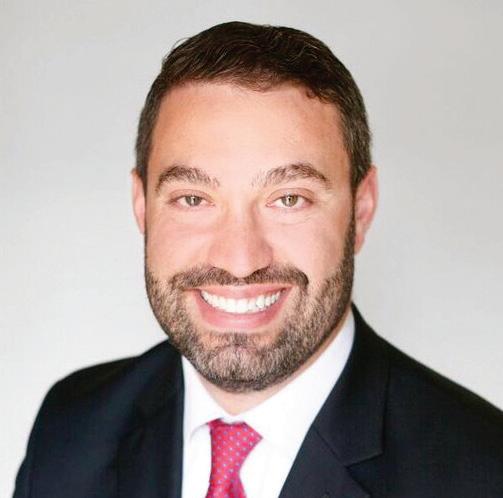 Giambelluca President,
Giambelluca President,
Now there’s an easier way to get one started, with impressive digital tools from Bank of America. Go to bankofamerica.com/twincities to learn more What would you like the power to do?®

Page 8 • January 30 2023 - February 5 2023 30, 2023 - 5, 2023 • Insight News insightnews.com
*Source: TIAA 2022 Financial Wellness Survey, Teachers Insurance and Annuity Association of America-College Retirement Equities Fund, 2022. Bank of America, N.A. Member FDIC. Equal Credit Opportunity Lender © 2023 Bank of America Corporation. All rights reserved.
Lucas
Bank of America Twin Cities
















 By Steve Abrams Minnesota House Session Daily
By Steve Abrams Minnesota House Session Daily



 By Tessa Pieper House Session Daily
By Tessa Pieper House Session Daily















































 By J. Darnell Johnson
By J. Darnell Johnson
































 Giambelluca President,
Giambelluca President,
